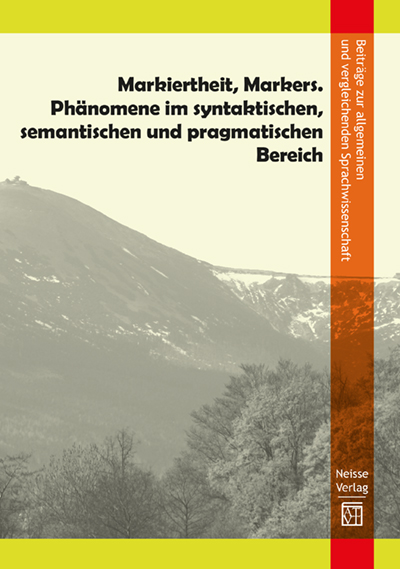
Beiträge zur allgemeinen und vergleichenden Sprachwissenschaft / Contributions to General and Comparative Linguistics
Issue 7 (2018): Markiertheit, Markers. Phänomene im syntaktischen, semantischen und pragmatischen Bereich
Edited by: Edyta Błachut, Adam Gołębiowski
Wie viel steht auf dem oder am Spiel? Diatopische Markiertheit von konventionalisierten Spielphraseologismen am Beispiel des österreichischen Deutsch / How much is auf dem Spiel or am Spiel? Diatopic marking of conventionalised game-phraseologisms depicted on the example of the Austrian Standard German
DOI: 10.23817/bzspr.7-1 (published online: 2021-04-02)
pp. 7–29
Keywords: phraseology, phraseologism, Austrian standard German, Austriacism, pluricentrism
The goal of this article is to analyse which idiomatic phraseologisms of the conceptual domain ‘game’ in the contemporary German standard language can be considered as ‘Austriacisms’ and how they are marked in a diatopic sense. First, the paper provides an overview of research on Austrian phraseology. Then, the term ‘Austrian phraseologism’ is defined. Finally, the paper discusses research on diatopic markers of Austrian phraseologisms. The article also explores a pluricentric approach to the game-phraseologisms present in the contemporary German standard language from the point of view of Austrian standard variety of German. It also shows how these phraseologisms can be analysed in the context of the concept of German as a pluricentric language.
Tilgung von Sprachlauten in den lexikalischen Entlehnungen aus dem Deutschen ins Polnische des 20. Jahrhunderts / Elision of language sounds in loanwords of German origin in the Polish language of the 20th century
DOI: 10.23817/bzspr.7-2 (published online: 2021-04-02)
pp. 31–43
Keywords: loanwords, language sound, elision, German-Polish contrastive studies
The aim of the present paper is to disscuss the elision of language sounds in loanwords transferred from German into Polish in the 20th century. Only those loanwords of German origin are examined whose time of transfer into Polish could be clearly indicated and whose etymology could be found.
Was markiert „jener“? / What designates the demonstrative “jener”?
DOI: 10.23817/bzspr.7-3 (published online: 2021-04-02)
pp. 45–56
Keywords: noun phrase, determiner, demonstratives, jener
This paper is a study of the meaning and use of the demonstrative jener in the contemporary German. The aim of this paper is to perform a corpus analysis of selected excerpts from texts including noun phrases with the demonstrative jener. All the examples are extracted from online versions of the weekly newspaper „Die Zeit“ published in 2018. The analysis carried out in this article intends to investigate how often and in what sense the demonstrative jener is currently in use.
Vorschlag als Sprachhandlungsmuster: Methodologie der kontrastiven Analyse am Beispiel des deutsch-polnischen Sprachvergleichs / The speech behaviour pattern of PROPOSAL: Methodology of contrastive analysis presented on the example of the German-Polish language comparison
DOI: 10.23817/bzspr.7-4 (published online: 2021-04-02)
pp. 57–87
Keywords: speech behaviour pattern, proposal, German, Polish, contrastive analysis, intercultural communication
The present paper aims to describe the speech behaviour pattern of PROPOSAL in German and Polish. The term “speech behaviour pattern” refers to the purposeful verbal behaviour. The illocutionary content of PROPOSAL is determined in accordance with the theory of semantic primes. The contrastive analysis has the following three aspects. First, typical implementation forms of this speech behaviour pattern are described in both languages. Then, their use in concrete functional and communicative contexts is exemplified. Finally, the composition of the communicative-pragmatic field of PROPOSAL is analysed in German and Polish. Particular attention is given to the central and peripheral forms of implementation as well as to the similarities and differences in the formulation of utterances expressing PROPOSAL in German and Polish.
Zum Nebensilbenvokalismus als Reflex des Entwicklungsstandes der deutschen Sprache im 17. Jahrhundert / On the vocalism of the unstressed syllables as a reflection of the development of the German language in the 17th century
DOI: 10.23817/bzspr.7-5 (published online: 2021-04-02)
pp. 89–103
Keywords: council, New High German, charter, unstressed syllables
The article presents a linguistic analysis of a charter from the 17th century entitled “Wilkierz dla wsi klasztoru Panny Marji w Kartuzach” published by Stanisław Kutrzeba and Alfons Mańkowski in 1938 in “Archiwum Komisji Prawniczej, volume 11”. The text of an unknown scrivener was written in New High German in the Silesian dialect, which can be proved on the basis of the legal notation. The author shows the results of his analysis demonstrating the stage of the development of the vowels in the unstressed syllables with the appropriate examples.
Markierte Intonation im wissenschaftlichen Vortrag. Eine Fallstudie / Marked intonation in spoken academic presentation. A case study
DOI: 10.23817/bzspr.7-6 (published online: 2021-04-02)
pp. 105–120
Keywords: marked intonation, case study, spoken academic language, GeWiss corpus
The purpose of this paper is to describe so-called “marked” intonation. What this means is that the intonation contour is indicated by a sharply rising pitch. This is a case study that focuses on the forms and functions of that type of rising intonation patterns which occur not in questions (interrogative mood) but in statements (indicative mood). The linguistic data consists of audio recording and transcriptions taken from the GeWiss, a comparative corpus of spoken academic language. The analysis shows that intonation contours are not subordinate to grammar and that they do not depend on modality.
Es regnete Anfragen und ehe er sich's versah, schneite ihm eine Überraschung ins Haus. Zur synchronen Variierbarkeit der Valenz der Witterungsverben / Es regnete Anfragen und ehe er sich's versah, schneite ihm eine Überraschung ins Haus. The synchronous variability of the valence of ‘weather’ verbs
DOI: 10.23817/bzspr.7-7 (published online: 2021-04-02)
pp. 121–144
Keywords: weather verbs, primary valence, valence enhancement
As a result of grammaticalisation processes, within various constructions the pronoun es could establish itself as the subject of these constructions. Amongst them, verbs describing the weather constitute a rather small and semantically defined verb subclass. The es-subject is regarded as a peripheral subject realisation with an abstract meaning. Since the ‘weather’ verbs are a verb group firmly anchored in the German verb system, analogous to other constructions, their primary valence varies too. The valence enhancement, i.e. the two- or multi-digit usage, allows the ‘weather’ verbs to be used as verbs of visual perception, verbs of movement, and verba dicendi. Based on the verb regnen ‘to rain’, the article more closely examines the synchronous variability of its valence.
Die Übersetzung eines künstlichen Dialekts im Roman David Mitchells „Der Wolkenatlas“ („Cloud Atlas“) / The translation of an artificial dialect in David Mitchell’s novel “Cloud Atlas”
DOI: 10.23817/bzspr.7-8 (published online: 2021-04-02)
pp. 145–161
Keywords: dialect translation, neologisms, preserving the style
The purpose of the present study is to analysis of the techniques applied by the translators of David Mitchell’s novel “Cloud Atlas” into Polish, German, French, Spanish, and Portuguese while translating the artificial dialect used in the chapter “Sloosha’s Crossin’ an’ Ev’rythin’ After”. The plot of that chapter is set in a distant future, after the fall of humanity. The narrator is a goatherd whose dialect can be described, on the one hand, as simplified, partly distorted English and, on the other hand, as an exotic dialect which contains neologisms referring to fictional species, culture-specific terms, etc. Special attention is paid to the translation of neologisms as well as to the rendering of the original style. As the results show, the translators used a number of techniques, especially lexicalization, colloquialisation and rusticalisation, adapting the dialect as much as possible to the morphologies of the target languages in order to preserve the style of the chapter as well as to achieve the appropriate effect on the TL readers. In fact, as the dialect is artificial, the translators were able to approach it in a creative way, without the risk that the dialect would be associated with a particular geographic region.

